

 |
||
 |
||
Vol. 8 (1): May 2005 |
Download this page
|
|
Greece / Italy / Mauritania & Western Sahara / Turkey
Greece
|
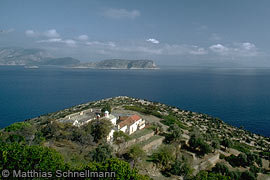 |
|
|
Greece’s flagship monk seal protected area. No management, no funds, no guarding, no development plan. |
Representatives of 9 NGOs gathered at the Athens headquarters of Greenpeace on 15 March to mark the government’s first anniversary in power and to explain to the public why the environment remains in limbo a full year after the prime minister’s pre-election promises.
Quoting from those pledges the press conference participants went on to identify environmental issues ranging from water resources to erosion, waste management to marine protected areas, alternative technology to uncontrolled development, where the government has allegedly failed to deliver – or indeed show any tangible sign of movement whatsoever – on its pre-election commitments.
The press conference brought together Greenpeace, WWF, Elliniki Etairia, Archelon, the Greek Ornithological Society/Birdlife International, Mediterranean SOS and MOm.
MOm highlighted the government’s continuing inaction on the protected areas of Greece – where funding cut-offs, guarding layoffs and wholesale disbanding of management authorities has effectively left the country without any protected areas worthy of the name [see Greek protected areas in limbo despite prime minister’s assurances, TMG 7 (2): November 2004].
While many new areas have been declared “protected” as part of the EU’s Natura 2000 network, without management, guards or budgets, the protection exists only on paper. In other cases, legislation still requires enactment before the areas in question will benefit from good intentions.
Following the conference, the organisations issued a list of 8 priorities requiring urgent action for the protected areas.
Greek Environment Minister, Giorgos Souflias, appeared to take the accusations personally. In a statement issued one day after the press briefing, the Ministry press office accused the NGOs of having a “hidden agenda”.
On 17 March, eight of the NGOs publicly refuted the government’s allegations, and a week later dramatically published an open letter in national newspapers, asking Giorgos Souflias directly, “When at last are you going to deal with the environment, Mr. Minister?”
The letter went on to note that:
The uncertain future of the National Marine Park of Alonissos, Northern Sporades (NMPANS) was underscored in March by a burglary at the Gerakas Research Station, where budget cuts have left the building unguarded, untended and uninhabited. A computer, VCR and VHF radio were stolen.
To make matters worse, the summer tourist season is fast approaching, a time when traditionally there are more frequent infringements of Park regulations.
Eleni Tounta, MOm’s coordinator for the NMPANS, worries that “this will be the second year in a row that the Park has remained unguarded.”
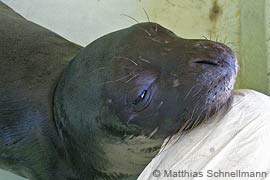 |
|
|
Hippocrates in the MOm rescue station on Alonissos. |
Orphaned monk seal pup Hippocrates, rescued on the Greek island of Kos in October, died suddenly on Monday 22 November with symptoms of acute enteritis [see Orphaned pup “Hippocrates” rescued on Kos, TMG 7 (2): November 2004].
A necropsy, performed in the Veterinary School of Thessaloniki by a specialized veterinary pathologist, Dr. N. Papaioannou, confirmed that the enteritis had resulted in cardiac pause and lung edema. The seal, which had been under care in MOm‘s rehabilitation centre on Alonissos for the past one and a half months, showed progress in development and behaviour, though a delayed increase in body weight.
Two days before his death, Hippocrates displayed the first symptoms of enteritis, which were treated with a light diet. Sadly, on the morning of the 22 November, he showed acute symptoms and died three hours later, the swiftness of the animal’s deterioration effectively preventing emergency intervention by the rehabilitation team. Samples analyzed by Erasmus University, Rotterdam, did not identify any underlying viral cause of the enteritis. – Jeny Androukaki, MOm.
At 01:57 on 5 November 2004, we received the last signal from “Dimitris”, the orphaned pup rehabilitated at MOm’s rescue station on Alonissos, and returned to the wild on 22 May 2004 [Clear blue horizon for Dimitris, TMG 7 (1): June 2004].
In accordance with initial predictions, the small satellite transmitter keeping us informed of his movements ceased functioning some 5,5 months after it was first attached, a time broadly coinciding with the animal’s first moult.
 |
|
|
|
Besides reaffirming his survival in the wild, the satellite also provided valuable scientific data, shedding light on little understood aspects of the species’ ecology, including movement between islands and diving depths. A record dive of 180 meters was registered, effectively re-writing earlier scientific estimates [Orphaned seal criss-crosses the Sporades Marine Park, sets new diving record, TMG 7 (2): November 2004].
The wealth of data collected is currently being analyzed and processed by MOm, and is expected to fill in other gaps in our scientific knowledge of species’ behaviour. – Panos Dendrinos, MOm.
Editor’s note: For further illustrated information on Dimitris’ rescue, rehabilitation and release, check out our News Archive page.
MOm has marked the end of its four-year LIFE programme in the Aegean by publishing a “layman’s guide” highlighting the challenges, significance and achievements of the project. The EU-backed programme implemented research and conservation objectives in two of Greece’s designated Natura 2000 areas, the N. Karpathos-Saria area in the southeastern Aegean, and the Kimolos-Polyaigos complex in the Cyclades [TMG Mediterranean News, passim].
During the programme, the monk seal population and its habitats were monitored, the degree of human intervention in the areas assessed and, following this, an adequate surveillance system designed for each area. Information and environmental education actions at the local and national level was also necessary, in order to make the local community and the wider public aware of the great ecological value of these areas and of the efforts to protect them.
In the Kimolos-Polyegos area, 32 newborn seals were recorded during the past four years. There are a large number of suitable cave refuges for resting and reproduction, which are used with considerably high frequency. Based on a combination of all relevant data, the minimum estimated population is 43 seals, which constitutes the second most important population in the Mediterranean.
In the N. Karpathos and Saria island complex, 19 newborn seals were recorded during the course of the program, and a combination of the available data leads us to estimate that the minimum population in the area is 23 seals.
Having carried out over 240 expeditions (600 hours of monitoring) in the marine area of Kimolos – Polyegos, the researchers of MOm reached the conclusion that the movement of tourist boats and small-scale subsistence fishing in the area of Kimolos constitute the most significant potential pressures on the marine environment.
Following 300 patrols (1,000 hours of recording) in the area of Karpathos, MOm concluded that the area is not under considerable pressure from human activities, but large-scale fishing constitutes a significant potential threat.
In both areas, the findings support the need for the adoption of protection measures, both near the Mediterranean monk seal refuges and in the major fishing grounds.
However, the most important result of actions in both these areas was the development of the necessary requirements (adequate infrastructure, trained and experienced human workforce, detailed knowledge on the use of marine zones) for the implementation of effective surveillance systems.
As a result of the programme, a complete picture has been acquired on the status of the Mediterranean monk seal populations; pilot conservation actions were carried out for subsequent implementation by the protected area management bodies, and the value of the natural environment of these areas was highlighted among locals and visitors. The active participation of schoolchildren constitutes possibly the most important achievement, since they will be the future users of these areas.
These achievements were possible despite the failure of the responsible Ministry for Environment to fulfill its financial obligations (€150,000) to the programme.
With its strategic objective being the creation of a network of protected areas for the monk seal, MOm will continue its actions in both areas. Nevertheless, we feel the need to stress that, to date, the basic requirement for the long-term protection of these areas – their institutional protection – has not been achieved. Believing that the efficient protection and ecologically sustainable development of these areas is a duty that lies with us all, we call upon the Ministry for Environment, the European Commission and all stakeholders to do all in their power to realize these aims. – Stella Adamantopoulou, MOm.
MOm. 2005. LIFE: Four years at a glance. The monk seal: Conservation actions in two Greek Natura 2000 sites. Hellenic Society for the Study & Protection of the Monk Seal (MOm), Athens, Greece: 1-12. [PDF ![]() 5.0MB]
5.0MB]
Following their historic exchange visits [see Developing closer ties between Turkey and Greece in monk seal conservation, TMG 7 (2): November 2004], representatives of the “monk seal communities” of Foça in Turkey and Alonissos in Greece have issued a joint statement pledging a commitment to sustainable development, a protection of ecosystems and the monk seal. [More…]
Since its establishment in 1991, the Rescue and Information Network (RINT) operated by MOm has received numerous seal sightings, thus enabling the society to estimate the distribution of the species in the country and in several cases closely monitor the status of specific individuals. Rarely however has a sightings account, and the fate of the monk seals involved in it, enchanted the people in MOm quite as much as an incident that took place last autumn in the coastal village of Platamonas in northern Greece.
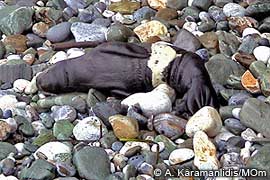 |
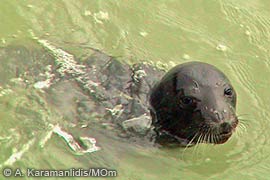 |
|
|
|
|
On the 13th of October, MOm was alerted by the port police authorities of Platamonas of a stranded monk seal pup near the village. Upon arrival at the location, the MOm rescue team found a newborn pup struggling to stay afloat under harsh sea conditions. After several hours of anxious efforts the pup managed to come ashore and find shelter on an open beach. All this took place under the wary surveillance of the pup’s mother and therefore the rescue team decided that there was no need for emergency intervention. Because of the bad weather conditions, however, a member of the rescue team remained on site in order to monitor the status of the pup during the following days. A close inspection of the area and enquiries amongst local residents revealed that the pup had been born approximately 500 meters from the village port, in a cave located beneath the foundations of a luxury holiday residence. Standing in the garden of the house, one could actually hear mother and pup vocalizing through the cracks in the earth!
Despite the “unconventionality” of the location of the cave, mother and pup (named “Belucci” and “Moskof” after the famous Italian actress and the owner of the holiday residence) remained in the area even after the bad weather conditions subsided and despite the fact that, due to the proximity of a settlement, human activity, including fishing, was intense. In fact, the seals even attained some local popularity, regularly attracting visitors from neighboring villages and featuring on local TV reports. MOm continued to check upon the status of the two until the 11th of November when mother and pup were last seen in the area. By that time, Moskof had moulted and grown into a healthy young pup. – Alexandros Karamanlidis, MOm.
Building on a long-standing and fruitful collaboration, MOm has been carrying out an IFAW supported project on seal-fisheries interactions since October 2004.
The project, which is expected to draw to a close this June, aimed to preserve important populations and habitats of the monk seal in the National Marine Park of Alonnisos, Northern Sporades and included two different sets of actions.
The first of these involved the continuation of MOm’s monitoring of the local monk seal population, with an emphasis on the reproductive season. During last year’s pupping season MOm’s field team managed to collect important information on monk seal habitat in the Park and record seven new births, providing additional evidence that the population remains reproductively active.
The second set of actions involved a preliminary analysis of the complex interactions between Mediterranean monk seals and the fishing sector.
A detailed profile of the fishing sector within the NMPANS was compiled, drawing on data from the port police authority and the local fishing cooperatives of Alonnissos. Approximately a quarter of all fishermen active within the Park were interviewed and essential information gathered on a range of issues including fishing techniques and areas, interaction with marine mammals, and the financial aspects of the Park’s fisheries sector.
Field trips on fishing vessels were also undertaken in order to evaluate and validate the results of the questionnaires.
By the end of the project, it is expected that an action plan will have been drawn up outlining ways in which seal-fisheries interactions can be mitigated, whilst also encouraging positive dialogue between conflicting parties. The action plan will be presented to the Management Authority of the NMPANS so that it can be adopted as part of the overall management plan of the Park. – Alexandros Karamanlidis, MOm.
In order to promote the conservation of the endangered monk seal in the country, the Hellenic government created in 1992 the National Marine Park of Alonnissos and Northern Sporades (NMPANS); this area is considered to be the most important habitat and to host the largest population of monk seals in the country. Acknowledging the fact that the effective operation of any protected area as a conservation measure depends greatly on the effective enforcement of the regulations governing it, and that this in turn is of extreme importance for the survival of the Mediterranean monk seal in the Northern Sporades, MOm (Hellenic Society for the Study and Protection of the Monk Seal) initiated in 1993 and has been carrying out continuously ever since a monitoring project in the area. This project aims to assist the relevant public authorities in the enforcement of the regulations of the NMPANS.
The first ten years of the operation of the project have been marked by significant results in the protection of the Mediterranean monk seal and the effective enforcement of the regulations governing the Park, which is one of the largest Marine Protected Areas (MPA) in the Mediterranean. During this time, the need for carefully planning and carrying out the monitoring project led to the formation of partnerships between MOm and various national and international organisations, throughout which, valuable experience and technical expertise was accumulated. Within the framework of the programme “Monitoring and Guarding the National Marine Park of Alonnisos & Northern Sporades”, funded by IFAW/International Fund for Animal Welfare, and in view of the operation of the recently-established management body of the NMPANS, MOm has proceeded in the compilation of a guarding manual. The manual records the experiences gathered throughout the monitoring project and presents recommendations towards the effective protection of the area. Its aim is to assist the management body of the NMPANS, which is responsible for the overall management of the area, in its initial steps of creating its own guarding/monitoring scheme and disseminate this unique knowledge to other MPA practitioners.
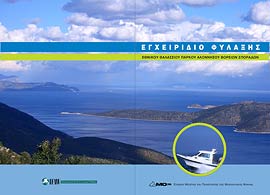 |
|
|
|
The manual consists of four distinct chapters. Chapter one serves as an introduction to the world of marine protected areas and the ways to monitor and protect them. Considering the fact that marine protected areas have yielded significant results both on the biological and socio-economic level, this chapter presents these results, the major research findings and three case studies and provides the reader the essential background knowledge in order to understand the structure and goals of the monitoring project in the NMPANS.
The second chapter of the manual begins with a short presentation of the Park including information on the biological, climatic, anthropological and cultural profile of the area. Building upon this information this chapter introduces the project itself. A necessary excursion in the legal framework of guarding and monitoring in protected areas in Greece leads up to a short presentation of the history of the ten year project. A big part of this chapter is devoted to the detailed presentation of the results of the monitoring effort and its significant effects on the enforcement of the regulations governing the area and the protection of the endangered Mediterranean monk seal. Within this context, an attempt is being carried out to highlight the importance of combining monitoring and guarding efforts with a well-planned information and sensitization campaign. This has been the case in the NMPANS and has led to the acceptance of the park by the local community. The second chapter ends with a brief analysis of the problems encountered throughout the project, the solutions given and the conclusions resulting from the planning and implementation of the guarding project for more than ten years.
One of the primary aims of the manual is to serve as a guide to the newly established management body of the NMPANS. This aim is achieved within the third chapter of the manual, where specific recommendations attempt to lead the reader step by step to the creation and operation of an effective monitoring/guarding programme of the area. The recommendations begin with the necessary legislative changes that should take place in order to create the most favourable conditions for the effective guarding and protection of the NMPANS. These recommendations could be broadened in order to encompass other protected areas as well, and would make the cooperation between relevant ministries and the management bodies easier. Following this, the necessary infrastructure and personnel are presented, as well as the methodology for effectively guarding, at a minimal cost, the National Marine Park of Alonnissos, Northern Sporades. Special attention has been given within this chapter to the important issues of the logistic requirements of such an undertaking and the application of alternative monitoring and guarding methods, that should be considered further by the management body of the NMPANS.
Finally, the last chapter presents the general conclusions resulting from the experience of guarding the NMPANS and the recommendations for effectively guarding all protected areas in Greece.
The manual was produced with the financial support of IFAW. – For further information, please contact Dr. Spyros Kotomatas, MOm.
Mediterranean News continues with Italy, Mauritania & Western Sahara and Turkey...
Copyright © 2005 The Monachus Guardian. All Rights Reserved |